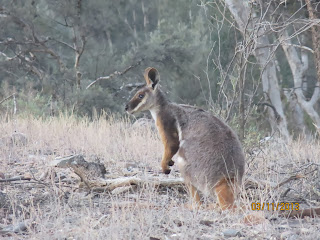As we don't yet have our Bushtracker caravan, we decided to take up a Travel Auction and bid for a few days at Arkaroola in the northern Flinders Ranges of SA. After a six hour trip from Adelaide through Burra and Orroroo, including a beer at the Parachilna pub with Jane and a night at Copley caravan park, we headed for Arkaroola on the dirt. Great road and well graded at the time. Very easy for a van if we had one - even an on-road van.
Arkaroola Village has all styles of accommodation, including caravan park and camping. We stayed in a basic motel suite for three nights at $90 per night including continental breaky. Great value - half price from the travel auction. Dining room for dinner was very good and general facilities more than you would expect in an isolated area. Backpacker and regular staff quite friendly, informative and committed. Fuel and supplies available.
The Ridge Top tour ($120 each) was excellent, showing us the full range of scenery, geology, plants and animals with an expert commentary by a geologist who was passionate about the area. The marvellous rock formations, the folding, faulting, volcanic activity and metamorphosis over millions of years and the long term wearing down of the rocks were all out there for us to see in one short 4 wheel drive trip. One stone the guide picked up was formed over four kilometers below the surface. Lots of long term erosion had revealed it on the surface. Another formation was formerly like Rotorua with its steaming mud, but was now a barren hill of fissures eroding in the sun. Great four wheel drive challenges in a few spots, including up Skennars lookout to a view across Lake Frome and beyond.
The landscape is amazing. A geosyncline from Gondwana times, the area was filled in over time with kilometers of sea floor detritus, building up to such a weight that it forced down the area around it to below current sea level. Large surrounding salt lakes like Lake Frome remain as evidence of internal drainage patterns. Fossils of the earliest life on earth were found by Reg Sprigg, the original owner of the conservation park, forcing geologists to change their description of geological time lines involving life.
Following sedimentation, the area was subject to the most amazing geological forces of uplift, tilt, volcanic intrusions, glaciers, heat and weight so that almost every type of geological outcome is evident in the rocks. After subsequent millions of years of erosion, what is left is a kaleidoscope of landforms, all within sight and readily accessible by bushwalking or 4 wheel drive track.
'Dry as' at the present, - probably going into the next four years of drought. But over the last few years it has been relatively wet - more than the usual glass of rain for the year - and there is a lot of new vegetation with a green tinge that is a little unusual. On our 4 wheel drive tracks we spotted bush banana, orange, curry plant and lots of new acacias and calliteris pines. Rock sida was growing to a meter when it normally stays as a little bush. Desert rose is in flower. White mullas have been flowering for several months and don't look like dying off.
Animals aplenty. Old man emus with their chicks. Euros in abundance along the creeks and the occasional skittish Yellow Footed Rock Wallabies, especially around the waterholes and by the camp at night. Big reds further out on the high open flat lands of the nearby national park. Very few reptiles, but lots of goats near the national park - a cause for some concern in the conservation area. Some flights of Port Lincoln parrot and plenty of smaller bush birds.
The area is privately owned but the bulk has been handed to a foundation to protect its future. Mining has been proscribed by law although the area has a long modern history of mineral exploration and some marginal exploitation. Mining tracks abound in the southern section, although the north is only accessible by foot. Originally 'no man's land' between various marginal sheep stations, it was indeed fortunate that Reg Sprigg was able to buy up the unwanted land and conserve it for present visitors.
Well worth the visit to see some of the most unique landscapes in this unique and ancient continent. It is amazing that more people don't realise the wealth, beauty and tourism riches that are for all to enjoy in Arkaroola. We will certainly take the van back there when we have the chance.












































No comments:
Post a Comment